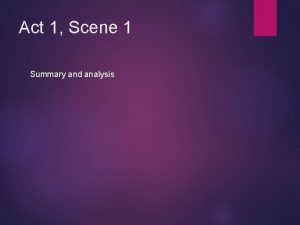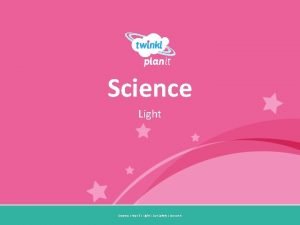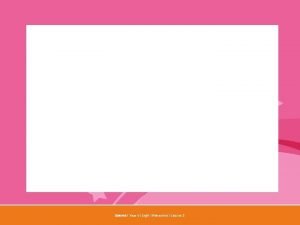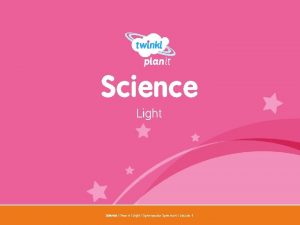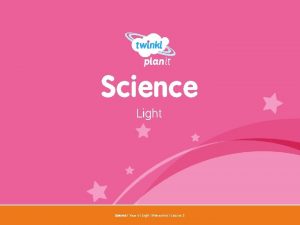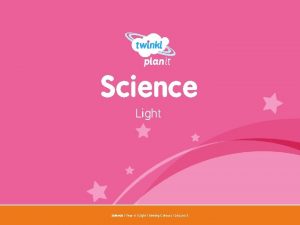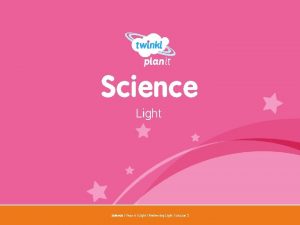Science Light Year One Science Year 6 Light


















- Slides: 18

Science Light Year One Science | Year 6 | Light | Reflecting Light | Lesson 2


• I can understand how mirrors reflect light, and how they can help us see objects.

Read the four explanations on the next slide of how light is reflected. Three of the explanations are false; only one of them is accurate! Have a look at the explanations, and make a decision about which one is the correct one. Place your vote!


The light ray that hits the mirror or other object is described as the incident ray, and the ray of light that bounces off is known as the reflected ray Reflection is when light bounces off a surface, changing the direction of a ray of light. All objects reflect light; smooth and shiny surface reflect all the rays of light at the same angle, rather than scattering the rays of light like rough or dull surfaces. incident ray

When rays of light reflect, they obey the law of reflection: The angle of incidence always equals the angle of reflection. The angle of incidence is the angle between the normal line and the incident ray of light. The red dashed line is called the ‘normal’ line. It is drawn at a right angle, or perpendicular to the reflector. angle of incidence angle of reflection The angle of reflection is the angle between the normal line and the reflected ray of light.

Try this challenge to prove the law of reflection! Use modelling clay to stand a mirror up on a piece of white paper. Make a very narrow slit in a piece of card. Dim the lights and shine a torch through the slit towards the mirror. On the white paper, look for the incident ray and the reflected ray of light. You may have to play around with the angle of the torch and the distance you hold it from the mirror.

Use a pencil and ruler to draw the incident and reflected rays on the paper. Draw a dashed line perpendicular to the mirror, from the point where the incident and reflected rays meet. This is the normal line. Use a protractor to measure the angle formed between the incident ray and the normal line. On the white paper, look for the incident ray and the reflected ray of light. You may have to play around with the angle of the torch and the distance you hold it from the mirror. They should be equal. Whenever light is reflected from a surface, it obeys this law.

The law of reflection is what allows us to see an object reflected in a mirror. Look at the way light travels to enable the boy to see his face reflected in the mirror: 1. Light from the bulb hits the boy’s face and bounces off. 2. The light reflected from the boy’s face hits the mirror. 3. The light reflected from the mirror travels to the boy’s eyes, so he can see the image of his face reflected in the mirror. 1 2 3

How is light travelling to enable the boy to see the computer behind the wall? wall

You are going to use your understanding of reflection and the angles of incidence and reflection to draw a periscope. A periscope is a device for seeing over or around something. Periscopes were first used by sailors in around 1860, who used them in submarines to see above the surface of the water. They were also used by soldiers in the First World War, to see over the top of their trenches. They are still used today by tanks and some submarines. A simple periscope is a tube with a mirror at either end. The mirrors need to be positioned so that the light is reflected from the mirror at one end, down the tube to the other mirror, then out of the tube to the observer’s eyes.

You are going to use your understanding of reflection and the angles of incidence and reflection to make a periscope. A periscope is a device for seeing over or around something. Periscopes were first used by sailors in around 1860, who used them in submarines to see above the surface of the water. They were also used by soldiers in the First World War, to see over the top of their trenches. They are still used today by tanks and some submarines. A simple periscope is a tube with a mirror at either end. The mirrors need to be positioned so that the light is reflected from the mirror at one end, down the tube to the other mirror, then out of the tube to the observer’s eyes.

Use a cereal box, scissors, 2 mirrors and sticky tape to make your periscope. You might use the template or you may try to construct your own! Use the instructions on the Making a Periscope Activity Sheet to help you.

Test out your periscope by using it to look over things, such as your table or chair, or around corners. Think about how it works. How is light reflected by the mirrors in the periscope? Complete your Periscope Activity Sheet with your ideas.

Mirror

• I can understand how mirrors reflect light, and how they can help us see objects.

 In what year is act one, scene one set?
In what year is act one, scene one set? Year 3 light
Year 3 light Light light light chapter 23
Light light light chapter 23 Into the light chapter 22
Into the light chapter 22 Chapter 22
Chapter 22 One empire one god one emperor
One empire one god one emperor One one one little dogs run
One one one little dogs run One king one law one faith
One king one law one faith Byzantine definition
Byzantine definition One ford behaviors
One ford behaviors See one do one teach one
See one do one teach one One price policy
One price policy Twelfth night speeches
Twelfth night speeches Studiendekanat uni bonn
Studiendekanat uni bonn Asean tourism strategic plan
Asean tourism strategic plan One vision one identity one community
One vision one identity one community English is my favourite subject noun
English is my favourite subject noun Poems about leaving school
Poems about leaving school 1 light year in km
1 light year in km
